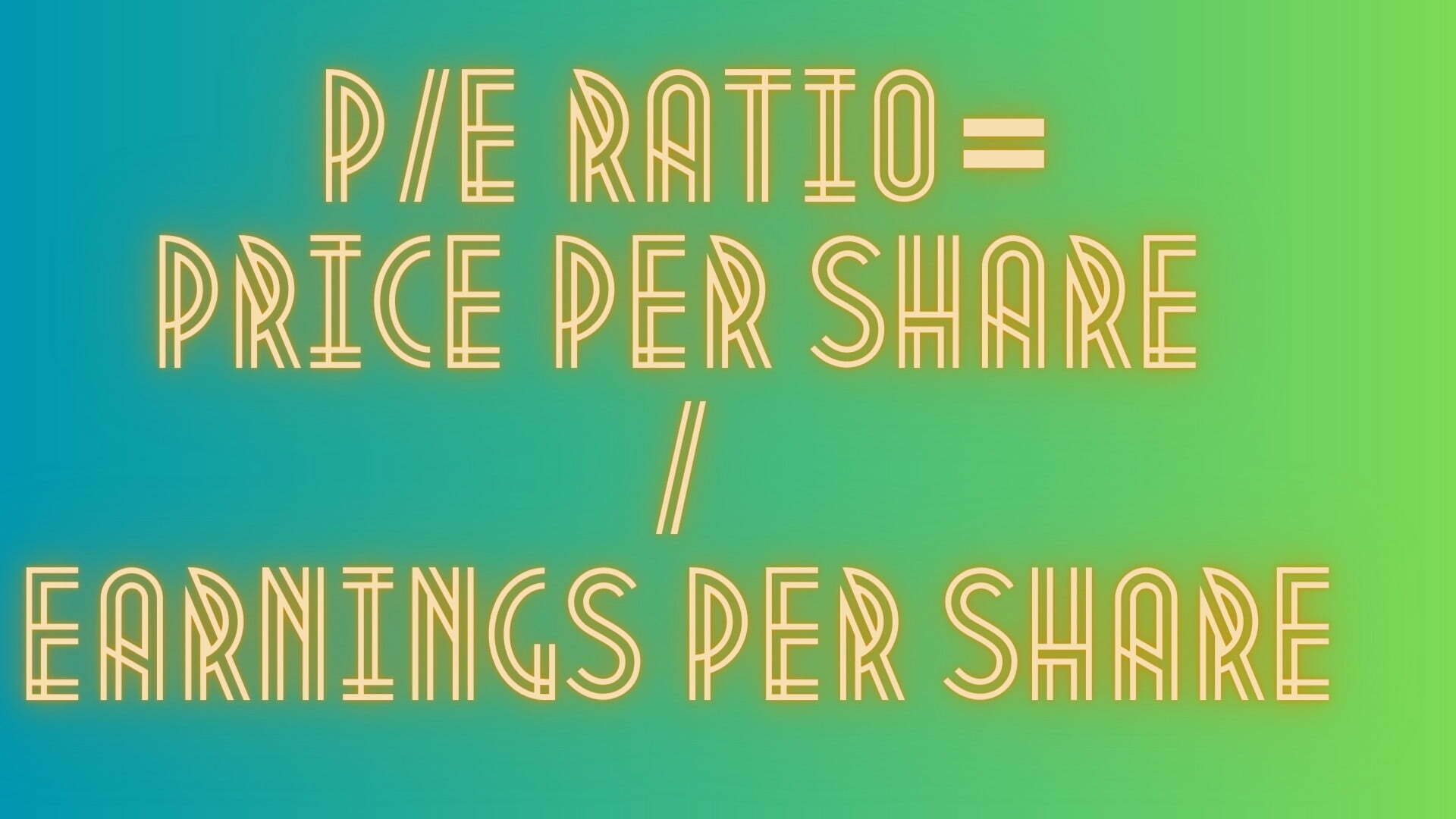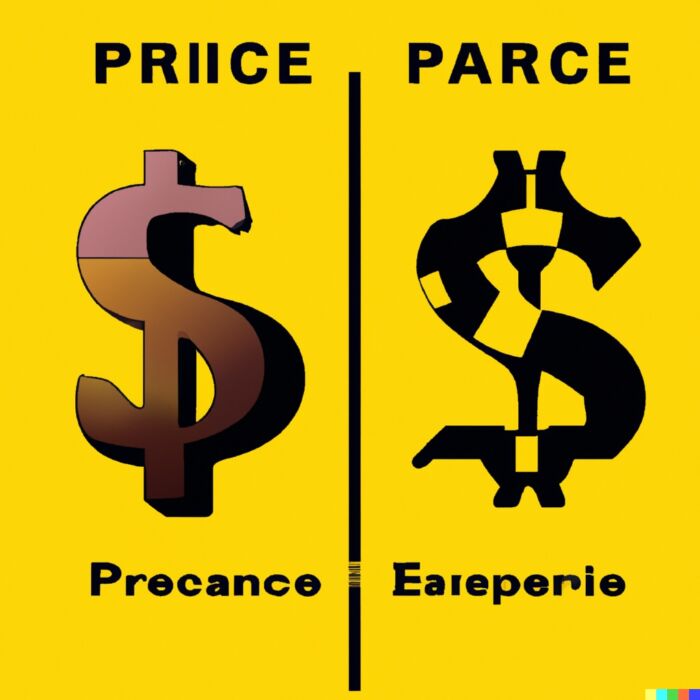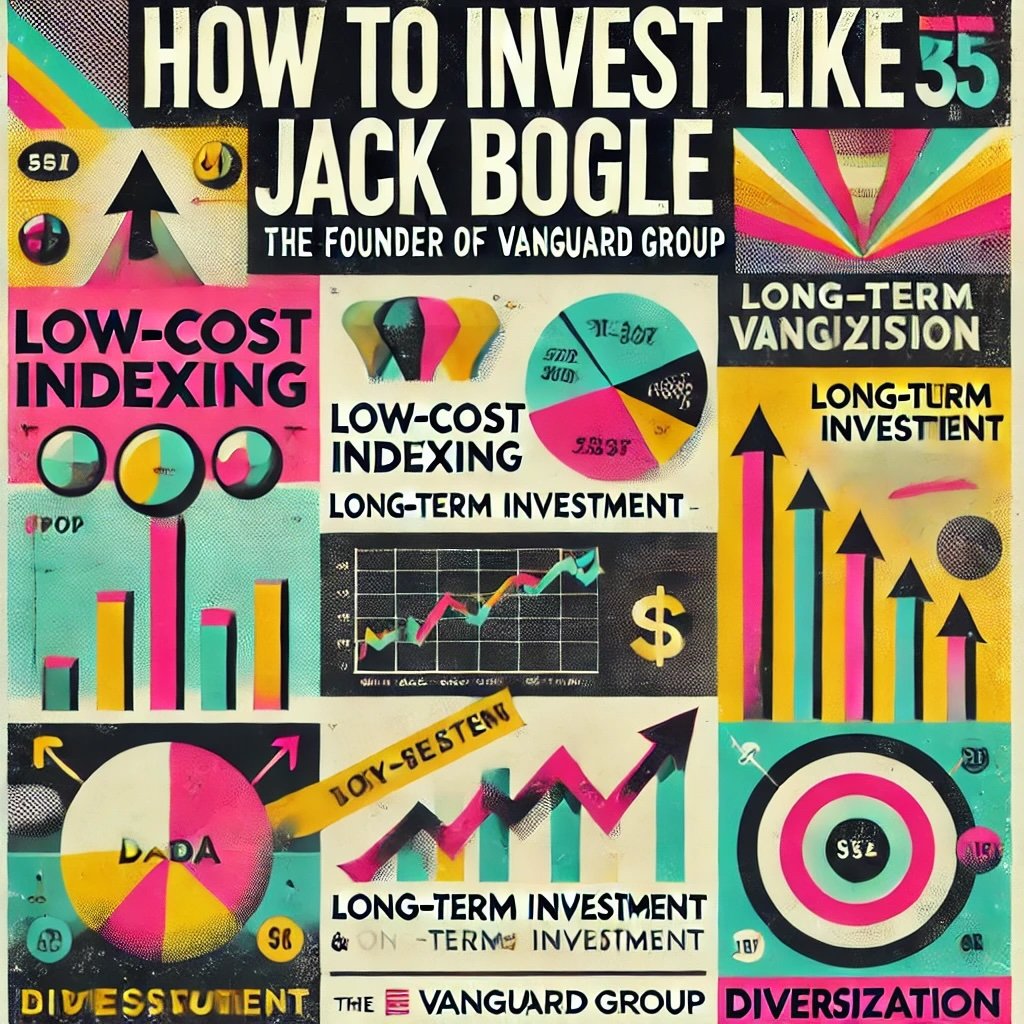If you’re a value investor, you probably know that finding undervalued stocks is a lot like a treasure hunt. And one of the most valuable tools in your treasure chest is the Price to Earnings Ratio (P/E Ratio).
The P/E Ratio is a metric that measures the price of a company’s stock compared to its earnings per share (EPS). In simpler terms, it tells you how much investors are willing to pay for each dollar of a company’s earnings. This is an important metric because it can give you insight into a company’s profitability and growth potential.

But why is the P/E Ratio so important for value investors? Well, it can help you identify companies that may be undervalued or overvalued by the market. A low P/E Ratio suggests that a stock may be undervalued, while a high P/E Ratio suggests that a stock may be overvalued. By comparing a company’s P/E Ratio to its historical average or to other companies in the same industry, you can get a better understanding of its true value.
In this article, we’ll dive deeper into the P/E Ratio and explore how value investors can use this metric to find potential investment opportunities. We’ll also discuss the limitations and cons of the P/E Ratio, as well as how it compares to other ratios like the Price to Book Ratio and Dividend Yield. So let’s put on our investing hats and get started!

Price To Earnings Ratio: How To Calculate P/E Ratio
To calculate the P/E Ratio, you’ll need to know a company’s stock price and its earnings per share (EPS). Here’s the formula:
P/E Ratio = Stock Price / Earnings Per Share (EPS)
For example, if a company has a stock price of $50 and an EPS of $5, its P/E Ratio would be:
P/E Ratio = 50 / 5 = 10

This means that investors are willing to pay $10 for every $1 of earnings generated by the company.
It’s important to note that the P/E Ratio can be calculated using either historical earnings or forward earnings estimates. Historical earnings are the company’s earnings over the past 12 months, while forward earnings estimates are projections of the company’s future earnings.
When using forward earnings estimates, it’s important to consider the reliability of the projections and any potential risks or uncertainties that could impact the company’s earnings in the future. This is why some value investors prefer to use historical earnings when calculating the P/E Ratio, as it provides a more reliable and accurate valuation of the company.

P/E Ratio: Some Hypothetical Examples
Let’s get super cheesy with some real life examples over here!
Let’s say you’re a value investor looking to buy stocks in the technology industry. You come across two companies: TechyTuesdayCo and SoftwareSaturday Inc. TechyTuesdayCo has a stock price of $100 and an EPS of $5, while SoftwareSaturday Inc. has a stock price of $50 and an EPS of $2.
To calculate TechyTuesdayCo’s P/E Ratio, you would divide its stock price by its EPS:
P/E Ratio = 100 / 5 = 20
So investors are willing to pay $20 for every $1 of earnings generated by TechCo.
For Software Inc., the calculation would be:
P/E Ratio = 50 / 2 = 25
This means that investors are willing to pay $25 for every $1 of earnings generated by SoftwareSaturday Inc.
Now, at first glance, you might think that TechyTuesdayCo is the better investment opportunity because it has a lower P/E Ratio. However, it’s important to dig deeper and consider other factors like the companies’ growth potential, financial health, and industry trends before making a decision.
But wait, there’s more! Let’s add some humour to this discussion. Imagine you’re trying to explain the P/E Ratio to your grandma who is not familiar with investing. You might say something like:
“Hey, Grandma, have you ever sold a lemonade for 50 cents and made a profit of 10 cents? That means your P/E Ratio was 5! You made a profit of 10 cents for every 50 cents of revenue. Now imagine if you could sell lemonade for $10 and still make a profit of 10 cents. Your P/E Ratio would be 100! That’s how investors think about the P/E Ratio for stocks.”
Okay, maybe that’s a bit cheesy, but you get the idea. The P/E Ratio is a simple yet powerful tool that can help value investors evaluate a company’s valuation and potential for growth.

Pros of Price to Earnings: Advantages Of P/E Ratio
As a value investor, the P/E Ratio can be a valuable tool in your investment analysis toolkit. Here are some of the advantages of using the P/E Ratio:
- Quick and Easy to Calculate: The P/E Ratio is a simple and straightforward metric that is easy to calculate. You only need two pieces of information: the stock price and the earnings per share (EPS). This makes it a great starting point for value investors who are looking to quickly screen potential investment opportunities.
- Valuation Tool: The P/E Ratio is primarily used as a valuation tool. It allows investors to compare the price of a stock to its earnings and assess whether the stock is overvalued or undervalued. A low P/E Ratio may indicate that a stock is undervalued and a good buy, while a high P/E Ratio may indicate that a stock is overvalued and a potential sell.
- Comparative Analysis: The P/E Ratio can also be used for comparative analysis. Investors can compare a company’s P/E Ratio to its peers or to the overall market to determine how it stacks up. This can help investors identify companies that are undervalued or overvalued relative to their peers or the market.
- Forward-Looking: The P/E Ratio can also be forward-looking, as investors can use forward earnings estimates to calculate the ratio. This can help investors get a sense of a company’s potential earnings growth and future profitability. However, it’s important to note that forward earnings estimates may be less reliable than historical earnings, as they are based on projections and subject to change.
- Consideration of Market Sentiment: The P/E Ratio can also be a reflection of market sentiment. A high P/E Ratio may indicate that investors are optimistic about a company’s future prospects, while a low P/E Ratio may indicate that investors are pessimistic. As a value investor, this can be valuable information when evaluating a potential investment opportunity.
It’s important to note that the P/E Ratio should not be used in isolation and should be considered alongside other metrics and factors. For example, a company with a low P/E Ratio may also have high levels of debt or poor financial health, which could make it a risky investment. As with any investment decision, it’s important to conduct thorough research and analysis before making a decision.
source: Let’s Talk Money! with Joseph Hogue, CFA on YouTube

Cons of Price to Earnings: Drawbacks Of P/E Ratio
While the P/E Ratio can be a useful tool for value investors, it’s important to understand its limitations and drawbacks. Here are some of the cons of using the P/E Ratio:
- Inaccurate Comparisons: The P/E Ratio can be inaccurate when comparing companies in different industries or sectors. This is because companies in different industries may have different levels of profitability or growth potential, making it difficult to make apples-to-apples comparisons. Additionally, companies in different sectors may have different P/E Ratio norms, making it difficult to determine what is considered “high” or “low” for a particular company.
- Fluctuating Earnings: The P/E Ratio can also be affected by fluctuations in earnings. For example, a company may have a high P/E Ratio during a period of strong earnings growth, but a low P/E Ratio during a period of weak earnings. This can make it difficult to determine the true value of a company over the long term.
- Limited Information: The P/E Ratio only takes into account earnings per share, and does not consider other important metrics such as revenue, cash flow, or debt levels. This can limit the amount of information available to investors when making investment decisions.
- Historical Analysis: The P/E Ratio is based on historical earnings data, which may not be indicative of future earnings potential. As a result, the P/E Ratio may not accurately reflect a company’s current or future earnings prospects.
- Accounting Methods: The P/E Ratio can also be affected by different accounting methods used by companies. For example, companies that use aggressive accounting methods may have higher earnings per share, leading to a lower P/E Ratio. However, this may not accurately reflect the company’s true earnings potential.
- Market Volatility: The P/E Ratio can be affected by market volatility, as stock prices can fluctuate rapidly in response to news or events. This can make it difficult for investors to accurately determine the true value of a company.
Overall, the P/E Ratio should be used in conjunction with other metrics and factors when evaluating investment opportunities. Value investors should consider the limitations of the P/E Ratio and conduct thorough research and analysis before making investment decisions.
source: ET Money on YouTube

P/E Ratio vs Other Investing Ratios
When evaluating investment opportunities, it’s important for value investors to consider a variety of financial ratios and metrics. Here are some comparisons of the P/E Ratio with other ratios:
- P/E Ratio vs. Price-to-Book Ratio (P/B Ratio): The P/B Ratio compares a company’s market capitalization to its book value. While the P/E Ratio is focused on earnings, the P/B Ratio is focused on a company’s assets. The P/B Ratio can be useful when evaluating companies with significant tangible assets, such as manufacturing or real estate companies.
- P/E Ratio vs. Price-to-Sales Ratio (P/S Ratio): The P/S Ratio compares a company’s market capitalization to its revenue. While the P/E Ratio is focused on earnings, the P/S Ratio is focused on revenue. The P/S Ratio can be useful when evaluating companies with high growth potential but low earnings, such as start-ups or companies in emerging markets.
- P/E Ratio vs. Dividend Yield: The Dividend Yield compares a company’s dividend payments to its stock price. While the P/E Ratio is focused on earnings, the Dividend Yield is focused on a company’s dividend payments. The Dividend Yield can be useful when evaluating companies with a history of paying dividends, as it can provide a source of income for investors.
- P/E Ratio vs. Earnings Yield: The Earnings Yield is the inverse of the P/E Ratio and measures a company’s earnings as a percentage of its stock price. While the P/E Ratio is focused on earnings, the Earnings Yield is focused on the return on investment that a company’s earnings provide to investors.
- P/E Ratio vs. Price-to-Cash-Flow Ratio (P/CF Ratio): The P/CF Ratio compares a company’s market capitalization to its cash flow from operations. While the P/E Ratio is focused on earnings, the P/CF Ratio is focused on a company’s cash flow. The P/CF Ratio can be useful when evaluating companies with high capital expenditures, such as those in the technology or energy sectors.
- P/E Ratio vs. Enterprise Value-to-EBITDA Ratio (EV/EBITDA Ratio): The EV/EBITDA Ratio compares a company’s enterprise value to its earnings before interest, taxes, depreciation, and amortization (EBITDA). While the P/E Ratio is focused on earnings, the EV/EBITDA Ratio takes into account a company’s debt and other liabilities. The EV/EBITDA Ratio can be useful when evaluating companies with significant debt, as it provides a more comprehensive view of a company’s financial health.
- P/E Ratio vs. Price-to-Free-Cash-Flow Ratio (P/FCF Ratio): The P/FCF Ratio compares a company’s market capitalization to its free cash flow. While the P/E Ratio is focused on earnings, the P/FCF Ratio is focused on a company’s ability to generate cash flow. The P/FCF Ratio can be useful when evaluating companies with significant capital expenditures, as it takes into account the cash flows that are available to pay dividends or invest in growth opportunities.
- P/E Ratio vs. Price-to-Operating-Cash-Flow Ratio (P/OCF Ratio): The P/OCF Ratio compares a company’s market capitalization to its cash flow from operations. While the P/E Ratio is focused on earnings, the P/OCF Ratio is focused on a company’s operating cash flow. The P/OCF Ratio can be useful when evaluating companies with high operating expenses, as it provides a more accurate picture of a company’s cash flow generating capabilities.
It’s important for value investors to consider a variety of financial ratios and metrics when evaluating investment opportunities. While the P/E Ratio can be a useful tool, it should be used in conjunction with other ratios and factors to gain a more complete picture of a company’s financial health and investment potential.
source: Rynance on YouTube
12-Question FAQ on the Price-to-Earnings (P/E) Ratio for Value Investors
What is the P/E ratio—really?
P/E tells you how many dollars investors pay today for $1 of a company’s earnings. It’s a quick valuation yardstick: Price per share ÷ Earnings per share (EPS). Lower can imply cheaper… if the earnings are durable and fairly measured.
How do I calculate P/E (and which earnings should I use)?
Basic formula: P/E = Price / EPS.
You can use:
TTM (trailing 12-month): objective, but backward-looking.
Forward (next 12 months): timely, but depends on estimates.
Normalized: adjusts for one-offs/cycle to better reflect true earning power.
What’s a “good” or “bad” P/E?
It depends on growth, quality, cyclicality, capital intensity, and rates. A P/E of 12 might be rich for a no-growth, highly leveraged firm, yet cheap for a durable compounding business. Always judge P/E relative to peers, history, and fundamentals.
How should value investors actually use P/E?
Treat it as a first-pass filter:
Compare to sector median and the firm’s own 5–10y history.
Ask why it’s cheap/expensive (growth, risk, accounting, cycle).
Triangulate with EV/EBITDA, P/FCF, ROIC, balance sheet before deciding.
What are trailing vs forward vs normalized P/E best for?
Trailing: sturdy baseline for mature, steady businesses.
Forward: faster signal for inflecting growth/recovery stories.
Normalized: best for cyclicals/commodities where single-year EPS is noisy.
Should I adjust P/E for the cycle (CAPE/Shiller-style)?
Yes for cyclical sectors. CAPE-like approaches average real EPS over many years (e.g., 5–10) to reduce boom-bust distortion, yielding a saner multiple across cycles.
How do growth and dividends change the P/E conversation (PEG/PEGY)?
PEG = (P/E) ÷ growth helps relate price to growth; PEG ≈ 1 is a common rule of thumb (not a law).
PEGY adds dividend yield to growth—useful for mature cash payers.
What if EPS is negative or distorted?
Traditional P/E breaks with negative EPS. Switch to EV/Revenue, EV/EBITDA, or P/FCF. Also beware distortions from one-time charges, stock comp, buybacks, and tax quirks—reconcile GAAP vs non-GAAP.
How do interest rates and inflation affect “fair” P/E?
Higher real rates and sticky inflation generally compress fair multiples (higher discount rates). Falling rates or credible disinflation support higher P/Es, all else equal. Always interpret P/E in its macro context.
Is P/E comparable across sectors and countries?
Only with care. Asset-heavy, regulated, or cyclical industries naturally have different P/E baselines than software or staples. Internationally, adjust for accounting regimes, margins, FX, and country risk.
What are the biggest P/E pitfalls?
Treating P/E as a standalone truth
Ignoring balance sheet (debt can boost EPS via buybacks)
Overlooking quality (moat, persistence of margins)
Using stale or cherry-picked earnings (one-offs, pandemic bumps)
Comparing outside sector context
What’s a practical P/E checklist before I buy?
Rebuild EPS (strip one-offs, stock comp view, tax rate).
Compare P/E vs sector & its own history.
Cross-check EV/EBITDA and P/FCF; sanity-check ROIC vs WACC.
Map growth runway (revenue, margins, reinvestment).
Stress test with rate/inflation scenarios.
Decide with a margin of safety, not just a low number.
Educational only. Not investment advice. Past performance is not indicative of future results.

Price To Earnings: P/E Ratio Final Thoughts
In conclusion, the P/E Ratio is a widely used valuation metric that can provide valuable insights for value investors. It measures the price of a stock relative to its earnings, and can help investors identify undervalued or overvalued companies. However, it is important to consider the limitations and potential biases of the P/E Ratio, such as the impact of accounting practices and the cyclical nature of certain industries.
When using the P/E Ratio to evaluate stocks, it is important to also consider other factors such as a company’s growth prospects, financial health, and competitive position. Additionally, comparing the P/E Ratio with other valuation metrics such as the ones mentioned earlier can provide a more comprehensive view of a company’s financial health and prospects.
Ultimately, the P/E Ratio should be used as one tool among many in a value investor’s toolbox. By combining the insights gained from various valuation metrics and factors, value investors can make informed investment decisions that have the potential to generate significant returns over the long-term.
Important Information
Comprehensive Investment Disclaimer:
All content provided on this website (including but not limited to portfolio ideas, fund analyses, investment strategies, commentary on market conditions, and discussions regarding leverage) is strictly for educational, informational, and illustrative purposes only. The information does not constitute financial, investment, tax, accounting, or legal advice. Opinions, strategies, and ideas presented herein represent personal perspectives, are based on independent research and publicly available information, and do not necessarily reflect the views or official positions of any third-party organizations, institutions, or affiliates.
Investing in financial markets inherently carries substantial risks, including but not limited to market volatility, economic uncertainties, geopolitical developments, and liquidity risks. You must be fully aware that there is always the potential for partial or total loss of your principal investment. Additionally, the use of leverage or leveraged financial products significantly increases risk exposure by amplifying both potential gains and potential losses, and thus is not appropriate or advisable for all investors. Using leverage may result in losing more than your initial invested capital, incurring margin calls, experiencing substantial interest costs, or suffering severe financial distress.
Past performance indicators, including historical data, backtesting results, and hypothetical scenarios, should never be viewed as guarantees or reliable predictions of future performance. Any examples provided are purely hypothetical and intended only for illustration purposes. Performance benchmarks, such as market indexes mentioned on this site, are theoretical and are not directly investable. While diligent efforts are made to provide accurate and current information, “Picture Perfect Portfolios” does not warrant, represent, or guarantee the accuracy, completeness, or timeliness of any information provided. Errors, inaccuracies, or outdated information may exist.
Users of this website are strongly encouraged to independently verify all information, conduct comprehensive research and due diligence, and engage with qualified financial, investment, tax, or legal professionals before making any investment or financial decisions. The responsibility for making informed investment decisions rests entirely with the individual. “Picture Perfect Portfolios” explicitly disclaims all liability for any direct, indirect, incidental, special, consequential, or other losses or damages incurred, financial or otherwise, arising out of reliance upon, or use of, any content or information presented on this website.
By accessing, reading, and utilizing the content on this website, you expressly acknowledge, understand, accept, and agree to abide by these terms and conditions. Please consult the full and detailed disclaimer available elsewhere on this website for further clarification and additional important disclosures. Read the complete disclaimer here.





